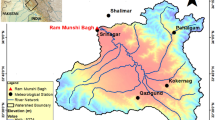Abstract
A coupled 1D-2D hydrodynamic model, MIKE FLOOD was used to simulate the flood inundation extent and flooding depth in the delta region of Mahanadi River basin in India. Initially, the 1D model MIKE 11 was calibrated using river water level and discharge data of various gauging sites for the monsoon period (June to October) of the year 2002. Subsequently, the calibrated set up was validated using both discharge and water level data for the same period of the year 2001. The performance of calibration and validation results of MIKE 11 were evaluated using different performance indices. A bathymetry of the study area with a spatial resolution of 90m was prepared from SRTM DEM and provided as an input to the 2D model, MIKE 21. MIKE 11 and MIKE 21 models were then coupled using lateral links to form the MIKE FLOOD model set up for simulating the two dimensional flood inundations in the study area. Flood inundation is simulated for the year 2001 and the maximum flood inundation extent simulated by the model was compared with the corresponding actual inundated area obtained from IRS-1D WiFS image.
Similar content being viewed by others
References
Bates PD, Lane SN and Ferguson RI (2005) Computational Fluid Dynamics: Applications in Environmental Hydraulics. John Wiley & Sons Ltd
Chow VT (1959) Open-channel hydraulics. McGraw-Hill International Editions
Danish Hydraulic Institute (DHI) (1997) MIKE 11 GIS reference and user manual. Horsholm, Denmark
Dhondia Z and Stelling G (2002) Application of one-dimensional - two-dimensional integrated hydraulic model for flood simulation and damage assessment, Intl. Conf. on Hydroinformatics, Cardiff, UK, Proc. 5:265–276
Kjelds J and Rungo M (2002) Dam breach modeling and inundation mapping. Danish Hydraulic Institute, Denmark
National Natural Resources Management System (NNRMS) (2000) Flood risk zoning report. Ministry of Water Resources, Govt. of India
Patro S, Chatterjee C, Singh R and Raghuwanshi NS (2009) Hydrodynamic modeling of a large flood prone river system in India with limited data. Hydrological Processes (in press)
Rungo M and Olesen KW (2003) Combined 1- and 2-dimensional flood modeling. 4th Iranian Hydraulic Conference, 21–23 Oct, Shiraz, Iran
Verwey A (2001) Latest developments in floodplain modelling 1D/2D integration. Proc. Conference on Hydraulics, Inst. of Engineers (Australia)
Werner M (2001) Impact of grid size in GIS based flood extent mapping using a 1-D flow model. Physics and Chemistry of the Earth, Part B: Hydrology, Oceans and Atmosphere 26:517–522
Werner M (2004) Spatial flood extent modeling — A performance based comparison. Ph.D thesis, Delft University, Netherlands
Author information
Authors and Affiliations
Corresponding author
About this article
Cite this article
Patro, S., Chatterjee, C., Mohanty, S. et al. Flood inundation modeling using MIKE FLOOD and remote sensing data. J Indian Soc Remote Sens 37, 107–118 (2009). https://doi.org/10.1007/s12524-009-0002-1
Received:
Accepted:
Published:
Issue Date:
DOI: https://doi.org/10.1007/s12524-009-0002-1




